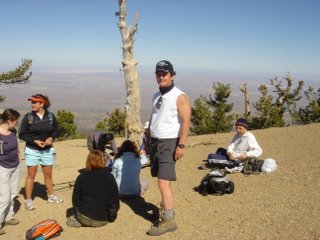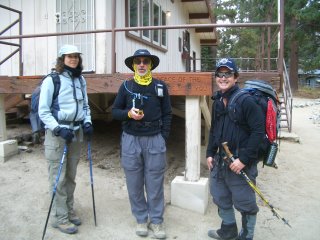Went on a hike with Kandy through Icehouse Canyon to observe the fall colors. Kandy made it to the top of Mt. Whitney this past August. We often discuss hiking together, but our schedules often conflict with other commitments. This time our schedules finally came to being.
 Kandy along the Icehouse Canyon Trail
Kandy along the Icehouse Canyon Trail
We started around 7:30 a.m. and took the Icehouse Canyon Trail all the way up to Icehouse Saddle. It was a little chilly at the start but as we made our way deeper and deeper into the canyon and as the sun started to rise over the saddle, things started to warm up. We stopped numerous times to take photos of the fall colors.
Pictures do this area an injustice. You have to be there to actually "feel" it.
Icehouse Canyon has a very remarkable history. There are remnants of an active past along the creek. There are foundations and chimneys where cabins once stood. In 1938, there was a large storm that created a flash flood 150 feet wide. The wall of water wiped out a majority of the cabins. Those who lost their homes in that flash flood decided never to rebuild. There are cabins that exist today along certain parts of the creek. I do not know if those cabins are actually from that era.
After reaching the saddle at 9:30 a.m., we stayed for 30 minutes before heading down the narrow and infrequently used Chapman Trail all the way back down to the canyon floor. Chapman Trail provides magnificent views of the surrounding mountains and the canyon from the north side of Icehouse Canyon. Certain areas of the trail remind me of certain sections of the Mt. Whitney Trail and Holy Jim Trail in Orange County. You do have to watch your step in certain sections. I stopped often to look for the elusive bighorn sheep along the mountainsides and did not see any.
 We stopped a hiker to see if he would oblige in taking our photograph.
We stopped a hiker to see if he would oblige in taking our photograph.
The following two pictures were taken by Kandy. She has a remarkable eye for detail.
We concluded our hike at 12:45 p.m. We calculated to have hiked 9 miles.
Sunrise over Icehouse Saddle.
We stopped at the Baldy Village Inn to grab some lunch. As I took care of the lunch bill (she drove), Kandy went over to the visitor center. After paying the tab, I went over there to look around myself since I hardly do. We obtained information from the ranger as to where we can best observe bighorn sheep in their natural habitat. The ranger said that you can best see them from across the trout ponds on the way to the Icehouse Canyon trailhead.
Next time...












